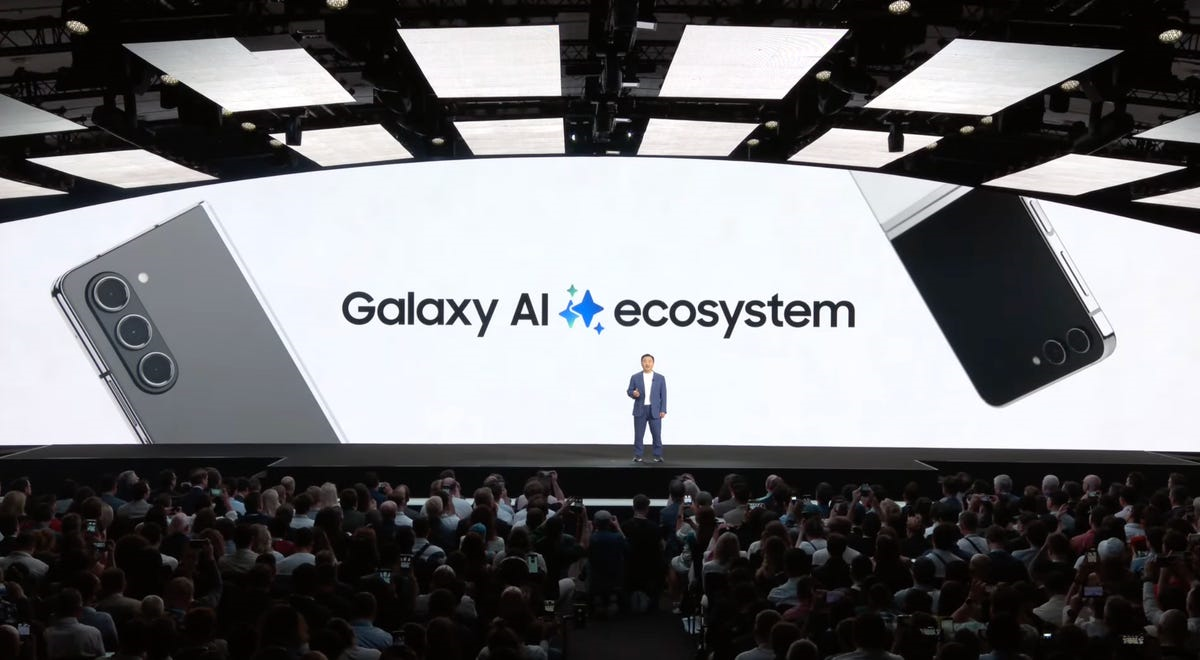Samsung and Google's Mysterious Mixed Reality Plans: What We Know So Far

Samsung, Google, and Qualcomm Collaborate on a Mixed Reality Project: What We Know So Far
One of the most interesting new mixed reality projects arriving in 2024 will be from a collaboration by Samsung, Google, and Qualcomm. It isn't without its whisperings in tech community circles about whether it may actually end up as the Android counterpart to Apple's Vision Pro, or another thing entirely: AI-powered smart glasses à la Meta's Ray-Ban Stories. But to now, very little has been divulged despite the great interest churned out over it.
While the three companies have assured that they indeed are collaborating, little has been shared on design or functionality of the product, or even when it will reach the public. But in what could be interpreted as a reassurance that the initiative is very much alive, Google's Rick Osterloh did appear at Samsung's recent Unpacked event in Paris.
Going forward, Osterloh said, "we're bearing down on ongoing opportunities for cross-Galaxy product experiences, from smartphones and wearables to even future technology like the upcoming XR platform—already deeply collaborative with Samsung and Qualcomm in relationship to next-generation devices. Stay tuned for more updates."
If any comment would suggest that Samsung, Google, and Qualcomm are getting back to mixed reality, where both the tech world and the user are witnessing sea changes due to the arrival of Apple's Vision Pro and generative AI that has made the virtual assistant conversational and capable. While we wait for word directly from Samsung, Google, and Qualcomm, let's dig into what can be divined from a series of interviews various Samsung executives have given throughout 2023 and 2024.
What We Know About the Mixed Reality Project
Up to the moment, little is known about the mixed reality project from Samsung, Google, or even Qualcomm. In fact, early last year, Samsung's mobile experience business president TM Roh already offered some hints in an interview with CNET. For him, these three firms will not be having more or less similar roles to what they have currently in the Android ecosystem. To this end, Samsung is said to make its respective Galaxy-branded Android hardware, while Google does the same for its Pixel line and Qualcomm provides tons of chips that power Android phones—Samsung included.
He added, "Each company is going to be leading on different lines on the projects and all three are working very, very closely to each other in across lots of categories".
One of the leaks that has emerged is the chipset that will power it: Qualcomm's Snapdragon XR2 Plus Gen 2. This second revision, which is already inside the Meta Quest 3 headset from Meta, promises a device from Samsung, Google, and Qualcomm, likely to be VR-like in nature rather than similar to smart glasses. It's going to be beautifully sized, loaded with higher-end capabilities such as 4K display support, or passed by high-quality cameras for mixed reality experiences.
An Open Platform Rather Than a Single Product
The minute takeaway from the briefing by Samsung executives is that this mixed reality project should be more about an open platform, and is not so much a singular, sweeping product tapestry, but something very much parallel to how Android acts as an open platform for thousands and thousands of varied devices.
He conceded that this approach might take longer to develop but is the right way forward.
"open platform" in which many third parties can contribute to. Not surprisingly, this represents hardly a departure from what Meta has been doing of late in actively opening its ecosystem to third-party manufacturers to launch headsets running its Horizon OS software.
Though, in the current scene, Meta does enjoy an upper hand with its already established ecosystem of Quest. The race would be damned close now if and when Google joins in with a new entrant. real hard-core, particularly mentioning the global reach of Samsung and the huge infrastructure for software of a gargantuan nature that both these competitors possess.
Productivity as a Potential Focus
Speaking of a use case of the mixed reality platform, Samsung executives have dropped a hint that productivity could possibly end up an area of emphasis. Roh noted how mixed reality could enhance everyday experiences, such as teleconferencing and its content consumption process, on larger virtual screens.
This jibes pretty well with Apple's approach to the Vision Pro, and it is not all that different from what Patrick Chomet, Samsung's executive vice president and head of customer experience, told CNET in an interview: produktivité a user can realize through mixed reality.
A headset like this is independent—a computer is included with the display unit—yet making a headset independent for the sake of copying human senses into a virtual space is a formidable challenge. Of course, in at least the near future, most mixed reality features turn to processing power and the connection of a smartphone in the pocket, Roh indicated. "Maybe that will change as the tech matures and one begins to coalesce around a vision, and once one starts to see mixed reality-specific applications and experiences developed that don't need a connection to a smartphone.".
The Role of Artificial Intelligence
Chomet said "the role of artificial intelligence in a project with that other leg up, mixed reality, is huge." In fact, artificial intelligence has been the area Samsung and the tech industry at large has focused on for 2024. He has hinted that this new mixed reality platform may incorporate some artificial intelligence in some meaningful way.
Specifically, "multimodal intelligence" involves advanced AI processes together to understand the gist of the intention of the user. Great utility in mixed reality, for Chomet, signifies strongly that AI has become mission-critical, especially big language models: The details of precisely how AI is integrated into the platform share nothing, but the general direction does:.
Speculations and Expectations
With such innovation likely to be unveiled by the likes of Samsung, Google, and Qualcomm, it pays to look back at where these companies have made their maiden forays into both VR and AR.
Though neither of these firms is quite an upstart in the world of VR, between Samsung with its Gear VR device in the mid-2010s and Google with Daydream View, in more accounts than one, they both represent something of fairly bottom-of-the-barrel and phone-based virtual reality experiences. For its part, Qualcomm appears boxed off in terms of working their way through both experiences of VR and AR since it's powering most devices available in the market.
With display and camera expertise under the Samsung wing, it is easy to suggest that Samsung might pull off a kind of a visual experience never seen before from this headset. More importantly, for non-telephony functions, Samsung and Google could gain numerous media factors, for instance on YouTube and YouTube Music, that might be manipulated into genuinely immersive 3-D video use out of the box.
Additionally, it will be quite easy for Samsung to manufacture phones that can already capture 3D photos and videos and then view them with the headset. One area where Samsung and Google greatly outclass Apple is related to device compatibility. Whereas the immediate competition, Apple's Vision Pro, works natively with just a connected Mac, Samsung could make its headset work across a wide base of devices: phones and tablets but also PCs and smartwatches.
Done right, that would give the edge to Samsung and Google over Apple in mixed reality. The Qualcomm XR2 Plus Gen 2 chipset can support as many as 12 sensors including cameras, which may give Samsung's headset the ability to pull off full motion tracking and eye-tracking.
It may also feature Google's radar-based Soli, which offers near-field gesture control for enhanced hand-tracking capabilities. That's, of course, purely theoretical. Certainly, no one from Samsung, Google, or Qualcomm is commenting about a new piece of hardware.
And there we stand—in dead silence—waiting for the brands to reveal that so-called mysterious device, which might as well be anytime in this coming year.
Conclusion
It is going to be a rather audacious/mind-blowing, broad move for Samsung, Google, and Qualcomm in their reality project, which has started fascinating both the tech industry and consumers in equal measure.
This alliance brings together some of the most powerful tech whizzes to signal a huge shift toward an integrated and immersive experience in the digital space. While all details relating to the project are not disclosed, their association with such tech giants itself indicates that something indigenously new is due at hand. Infuse AI into this mixed reality platform, and there could be a virtually immersive but highly personalized and adaptive commercial tailor. This just is the kind of platform that might blur the lines between the digital and physical worlds, having very wide scope applications linked into it within the domains of gaming, health, and so forth.
What's more, the fact that the platform itself is going to be open is very exciting, showing us a future where developers from all walks of life can chip in and make additions to stimulate a potential scale of innovation and creativity we've never seen. With only crumbs of information, it's sure to stir up a frenzy in the tech community, and everyone's on their edge, speculating and hypothesizing. In fact, this collaboration can turn our perspective into a new frontier of technological development just as soon as mixed reality interweaves our lives. Fulfillment of a vision may change it all—reset how we process and interact with our environment—from the mere anticipation. All eyes are on it, and the potential impact can be massive.
FAQs
1. What will be the probable price of the Samsung Google Qualcomm mixed reality headset in India?
Although cost numbers related to this mixed-reality headset from Samsung, Google, and Qualcomm are currently a closely guarded secret, if foreign industry watchers were to be relied upon, such pricing would easily fall in the range of Rs 2.5-3.50 lakh in India. Priced according to these technical requirements, this is an estimate of some of the visuals coming at one at this time of writing that are on the global market currently for this high-end Mixed Reality device. Advanced hardware, the leading-edge display flexibility, seamless integration into AI, and a XR2 Plus Gen 2 chipset—hey, if all those were features, this indeed would justify the huge price tag for this newfangled device.
2. Does a mixed reality headset work with a smartphone?
Ideally worn around a smartphone, this reality-mixing headset is intended to hijack the mobile device for processing and connectivity duties. This would be easy self-use of mixed reality with just about everybody's smartphones all already in the harsh world outside—a possibly straightforward approach for easy use among the general populace.
Still, once the technology develops adequately in maturity and deployment, some future version of the headset may indeed go standalone—in which case one would not need the telephone connection. This would entirely make the user experience vivid and let mixed reality environments be free from mobile device dependency.
3. What is a Snapdragon XR2 Plus Gen 2 Chipset?
The Snapdragon XR2 Plus Gen 2 is the latest processing technology that Qualcomm has cooked for use with mixed reality headsets. It is packed with a high-resolution display processor to ensure sharp and clear visualization for an immersive experience. In addition, XR2 Plus Gen 2 is equipped with multi-sensing, realizing accurate motion and gesture tracking useful within mixed reality environments to realize frictionless interaction. Basically, the chipset is what enables AI-driven features to be intuitive and immersible and responsive in the user interface; hence, it is the backbone of the next-generation mixed reality devices.
4. What is the tentative month when mixed reality headgear will finally arrive in India?
"While industry insiders say the exact date for the launch of the mixed reality headset is yet to be reverted, the device from Apple is likely to hit the Indian markets by the end of 2024. That will bring into a line, like rollout plans for similar devices to key markets globally, around a similar period.". This Indian launch, definitely, will not be much long from the world release, just a bit of time for its localization and adaption to the Indian market. Its launch specifics will be revealed closer to the end of this year.
5. What would AI's integration on the Mixed Reality be?
AI's ability on this mixed-reality platform is anticipated to cause a whole lot of change mostly with features of multi-model intelligence. It includes image, speech, and text processing to make it more interactive for user interaction. It will then form the core that understands and responds to the other input by the users in real time, thus allowing perfect interaction in the virtual environment. AI allows dynamic generation of content or further adaptation of a case based on user behavior. End. This will greatly enhance the functionality of the Mixed Reality platform and attract more people.





